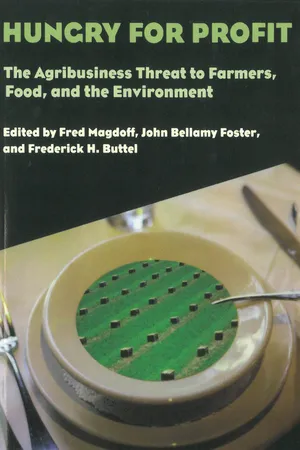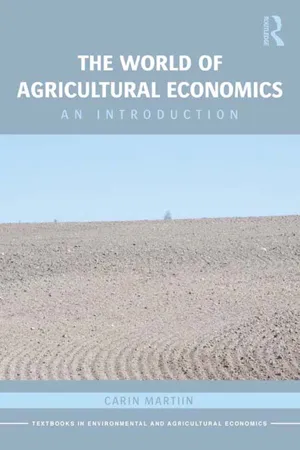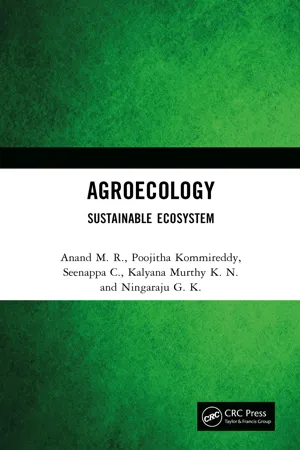Geography
Monocropping
Monocropping refers to the agricultural practice of growing a single crop on the same land year after year. This method is often used in large-scale industrial farming to maximize production of a specific crop. While monocropping can increase efficiency and yield, it can also lead to soil degradation, increased susceptibility to pests and diseases, and loss of biodiversity.
Written by Perlego with AI-assistance
Related key terms
Related key terms
1 of 4
Related key terms
1 of 3
3 Key excerpts on "Monocropping"
- eBook - ePub
Hungry for Profit
The Agribusiness Threat to Farmers, Food, and the Environment
- Fred Magdoff, John Bellamy Foster, Frederick H. Buttel(Authors)
- 2000(Publication Date)
- Monthly Review Press(Publisher)
6The technologies that allowed the shift toward specialization and monoculture were mechanization, the improvement of crop varieties, and the development of agrochemical to fertilize crops and control weeds, insects, and other crop pests as well as antibiotics and growth stimulants for agricultural animals. United States government commodity policies over the last several decades encouraged the acceptance and utilization of these technologies. In addition, the largest agribusiness corporations have found that concentrating certain processing facilities for a given product (chickens, hogs, or wheat) in specific areas of the country produces more profits, which lead to more farm and regional specialization. As a result, farms today are fewer, larger, more specialized, and more capital intensive.From an ecological perspective, the regional consequences of monoculture specialization are many-fold:7(1) Most large-scale agricultural systems exhibit a poorly structured grouping of farm components, with almost no linkages or complementary relationships between crop enterprises, and among soils, crops, and animals.(2) Cycles of nutrients, energy, water, and wastes have become more open, rather than closed as in a natural ecosystem. Despite the substantial amount of crop residues and manure produced on farms, it is becoming increasingly difficult to recycle nutrients, even within agricultural systems. Animal wastes cannot economically be returned to the land in a nutrient-recycling process because animal production is frequently geographically remote from where crops are grown. In many areas, agricultural waste has become a liability rather than a resource. Recycling nutrients from urban centers back to the fields is similarly difficult. - eBook - ePub
The World of Agricultural Economics
An Introduction
- Carin Martiin(Author)
- 2013(Publication Date)
- Routledge(Publisher)
Together with increased cultivation of grass and clover, the idea of systematic crop rotation made it possible to increase production without impoverishing the soil. By this means farmers experienced a relief from some of the constraints of the so-called ‘Malthusian trap’, mentioned in Chapter 5. Today, the principle is as relevant for market and subsistence oriented farming, and rotation as such can principally be managed without expenditures. Alternatives to monocultures In addition to monocultures, where one crop is grown per field, you may also come into contact with so-called multiple cropping, where two or more species are grown together in various ways. The combinations are many, such as roots and permanent crops, or crops sown at the same time but harvested separately and at slightly different points in time. The combination of different crops makes it complicated to mechanize this kind of crop farming but can be advantageous in other ways. Different plant height can create a welcome shadow for the lower vegetation, and various root system depths can make it possible to utilize nutrients at different levels in the soil. In addition, multiple cropping can be favourable in view of weeds and pests. It is, for example, easy to imagine the bigger risks of insect invasions in big monocultures compared with a piece of land where a row of cassava is planted next to a row of maize. So-called cover crops So-called cover crops should also be mentioned. The idea of cover crops is not to produce a specific crop for sale or consumption, but rather to provide a number of other benefits in terms of resources and environmental gains. Cover crops are not specific kind of plants, but crops that are suitable for a specific task, for example to reduce nutrient leakage from soils into water courses; improve the soil structure and soil ecosystem; fix air-borne nitrogen; promote carbon sequestration - eBook - ePub
Agroecology
Sustainable Ecosystem
- Anand M. R., Poojitha Kommireddy, Seenappa C., Kalyana Murthy K. N., Ningaraju G. K.(Authors)
- 2023(Publication Date)
- CRC Press(Publisher)
Gliessman (1992 ) defined ‘agro-ecology’ as the application of ecological concepts and principles to the design and management of sustainable agricultural systems. The agro-ecological environment of a crop, land use or a farming system covers physical, chemical and biological aspects. There is need for integrating the overlapping ecological and environmental traits with sociological, economic, political and other cultural components of agriculture. In order to avoid confusion between the tasks of crop ecology and ecological crop geography, the study of the former should be confined to investigation of the relationships of crop plants to their physiological environments to the exclusion of the economic factors encountered in the production and distribution of a crop or group of crops. The effects of both physiological and economic factors on production and distribution of crops are treated in the field of ecological crop geography.Cultivation of crops has become a part and parcel of our life. For getting best results in farms and fields ecological principles have to be applied. Crop ecology is therefore, become an important subject of study for successful agriculture. Crop ecology is concerned with the management of soil for growing of crops.The best example of applied ecology is agriculture since the entire problem of crop production is an ecological problem. A particular crop ecosystem thrives only in particular climate and edaphic conditions. The first job of a crop ecologist is therefore to select a plot of land in a place where the climatic and soil conditions are suited to the particular crop. Soil fertility is getting depleted due to continuous cropping. A crop ecologist applies his knowledge of the nutrients requirements of the crops in such situation. By applying manures and fertilizers he restores the fertility of the soil and once again a good yield can be expected. A crop ecologist should also pay attention to the improvement of soil condition by adopting methods for soil conservation and for control of soil erosion. Maintenance of soil fertility can be ensured by the application of the ecological principle of crop rotation. The nutrient cycling of the ecosystem is thus balanced.
Index pages curate the most relevant extracts from our library of academic textbooks. They’ve been created using an in-house natural language model (NLM), each adding context and meaning to key research topics.
Explore more topic indexes
Explore more topic indexes
1 of 6
Explore more topic indexes
1 of 4


